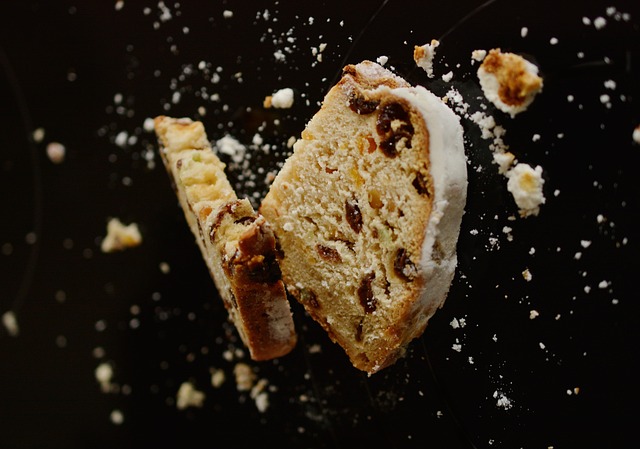
As we explore the unique culinary traditions across the world, Germany’s rich food culture serves up a sweet surprise – the Stollen bread. This distinctive and festive bread, dusted with powdered sugar to resemble the snow-covered landscape of winter, takes center stage during the holiday season. It’s a beloved food tradition that embodies centuries of German history and culture. So, let’s journey back in time and unfold the delightful story of Stollen bread.
Origin of Stollen
Stollen has its roots in the early 15th century in the city of Dresden, located in eastern Germany. Initially, this festive bread wasn’t the sweet delicacy we know today. The Catholic Church during the Advent season, the period leading up to Christmas, imposed strict fasting rules which prohibited the use of butter or milk. As a result, the early versions of Stollen were somewhat plain and hard, made primarily from oats, water, and turnip oil.
However, things started to change in 1490 when Ernst of Saxony and his brother Albrecht sent a letter to Pope Innocent VIII. They asked for a special dispensation to use butter in their Stollen. This is famously known as the “Butter-Letter”. Although the Pope’s initial response was negative, they persisted, and finally in 1491, the Pope lifted the ban. With this change, the Stollen gradually evolved, becoming richer and tastier over time.
Dresden Stollen: The Emblem of Christmas
As the Stollen bread began to gain popularity, Dresden emerged as the epicenter of its production and sale. By the 16th century, Stollen was so integral to Dresden’s holiday traditions that it was used as a Christmas gift for royalty and nobility. It’s worth noting that the bread was shaped to resemble a swaddled baby Jesus, a symbolism that further enhanced its association with Christmas.
The 18th century saw the tradition of the Dresden Christmas market, known as Striezelmarkt, where bakers started the tradition of baking a giant Stollen. This tradition, known as the Dresden Stollen Festival, is still carried on to this day, with the annual highlight being the grand parade featuring an enormous Stollen bread carried on a horse-drawn carriage.
Traditional Ingredients and Symbolism
Stollen bread is rich with dried fruits, nuts, spices, and sometimes marzipan, making it a delightfully aromatic and tasty holiday treat. It’s traditionally dusted with powdered sugar, symbolizing the baby Jesus in swaddling clothes.
Stollen is not just about the taste but also the ritual. The process of making this bread requires time and patience, as the dough needs to rest and the flavors to develop. This lengthy process represents the anticipation and waiting that marks the Advent season.
Stollen in Today’s World
Over centuries, Stollen has remained a beloved culinary tradition, especially during Christmas. It has spread far beyond the borders of Germany and is now enjoyed worldwide. Different regions have added their unique touch, leading to a variety of Stollen such as butterstollen, marzipanstollen, and quarkstollen.
However, the true Dresden Stollen, Dresdner Christstollen, is recognized and protected by the European Commission as a regional specialty, similar to the protection afforded to Champagne in France. To be labeled as such, the Stollen must be made in Dresden and follow specific ingredients and recipe guidelines.
Stollen bread, with its centuries-old history, symbolizes the spirit of celebration, togetherness, and joy that defines the holiday season. The tradition of baking and sharing this delectable bread binds communities, transcends borders, and carries forward the rich culinary heritage of Germany. Every bite of this festive bread is a reminder of its fascinating journey – from a simple fasting bread to a cherished holiday delicacy.
Related Articles:
How Germany Became the Land of Bread
Traditional German Stollen Bread Recipe
Eierlikör – Traditional German Egg Liqueur Recipe
Eierlikörtorte – Traditional German Egg Liqueur Cake Recipe
